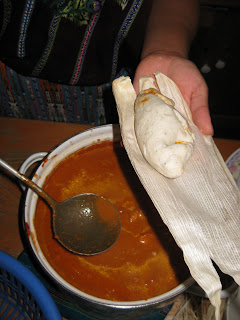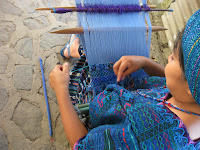
Meanwhile there are pumpkin seeds (pepitos) that have been rinsed and cleaned and are set on low heat to toast lightly. This is about 1 1/4 cup of seeds. When they are done set them aside in a bowl to cool.When your pumpkin seeds are done toasting, clean an equal amount of sesame seed and toast lightly. These get blended to a smooth paste using some of the tomato water. Run through a sieve to make a smooth sauce.



The tomatoes and chilis are simmering gently to make the sauce. When they are nice and soft they are pureed in the blender to make a lovely rich sauce, save aside some of the tomato juice to use when the seeds get pureed. Run the tomato chili sauce through a colander to make sure it is very smooth. Return the tomato sauce to the heat and add the pureed seeds and then add chicken, about 4 large breasts that have been cut up into 1-2" pieces, the skin is removed but bones are left in for added flavor. Cook until the chicken is done, about 12 minutes. Remove from heat and set aside while everything is gathered for assembly!



 In the meantime the corn husk wrappers are prepared by separating and washing in clean water.
In the meantime the corn husk wrappers are prepared by separating and washing in clean water.Now comes the manual labor, for this recipe about 20 cups of masa is kneaded together with about 1 cup of safflower oil (some people use lard) and salt to taste (about 3-4 tablespoons), adding water as necessary to create a smooth, pliable dough.



I give up trying to get the pictures in sequence!!
Take some of the masa and pat out a fat tortilla, place a good dollop of sauce and a piece of chicken and fold the dough over the filling. Place it in one or 2 corn husks for wrapping. Tie it up into a nice bundle and pile them into a large kettle which has been prepared by layering in about 2" of dry corn husks and water so the chuchitos steam gently for about 1-2 hours depending on your fire. Then get ready to eat a whole lot, for dinner, breakfast and then lunch again!





















